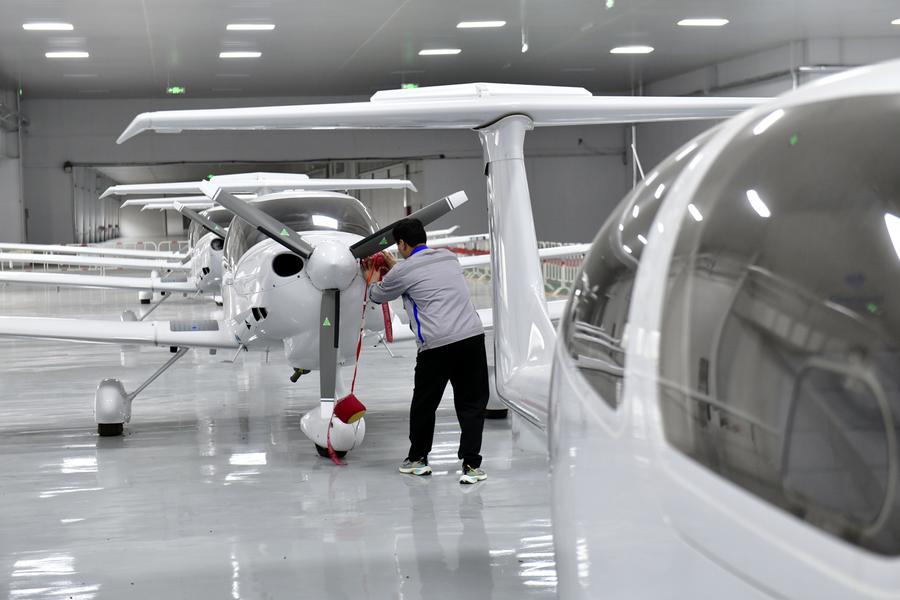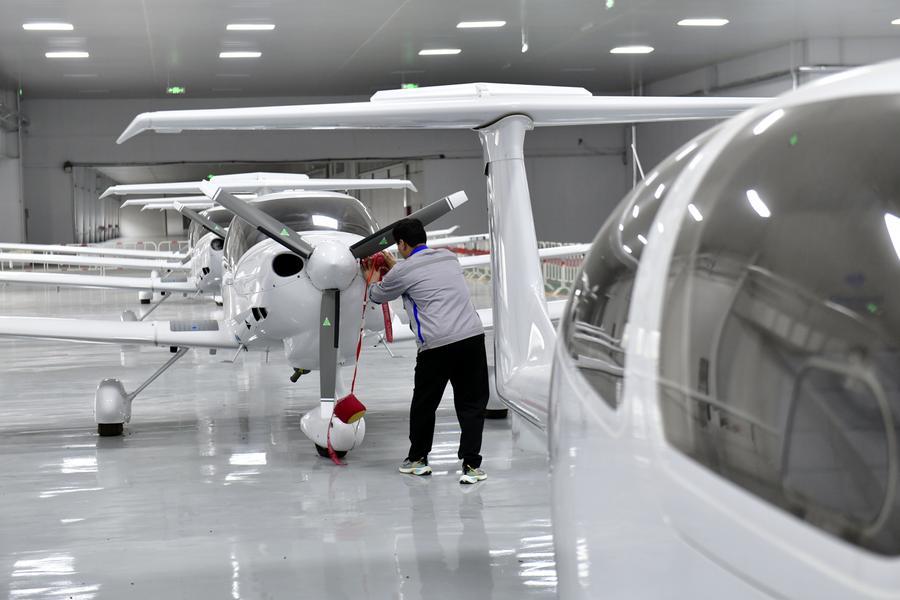
A staff member assembles an aircraft at a hangar of a high-tech industrial park in Binzhou, east China's Shandong Province, Oct. 9, 2024. (Xinhua/Guo Xulei)
BEIJING, Nov. 28 (Xinhua) -- Solid-state batteries and the low-altitude economy, as driving forces for each other, are jointly opening up new space for development.
According to the estimation of the Civil Aviation Administration of China (CAAC), the market size of China's low-altitude economy is likely to reach 1.5 trillion yuan by 2025, and exceed 3.5 trillion yuan by 2035. As an important power option for low-altitude aircraft, solid-state batteries are expected to be significantly needed.
It is learned that the current threshold requirement for battery energy density by leading eVTOL (electric vertical takeoff and landing) enterprises is about 300Wh/kg, with a cycle life of 500 times, and it will continue to increase in the future, posing very high requirements and expectations for the development of solid-state batteries.
-- Low-altitude economy opens up new market for solid-state batteries
In the coming years, with the intensive approval of eVTOL airworthiness certificates for various companies, the low-altitude market is expected to usher in a period of explosive growth, introduced Zhang Hong, vice president of EHang, a Chinese urban air mobility technology company, at an industrial conference held recently.
Low-altitude aircraft manufacturing is a key part of the low-altitude economy, while solid-state batteries are a key option of power source for eVTOL power systems.
It is learned that the proportion of batteries in eVTOL costs is approximately 10 to 20 percent. Although it may change as the industry is still in its early stages, batteries will be an important value component of eVTOL within the expected range.
The low-altitude economy requires solid-state batteries, and solid-state batteries also need the market brought by the low-altitude economy.
According to a research made by GG Industry Institute (GGII), emerging markets, involving battery swapping, special power, eVTOL, exoskeletons, robots, electric motorcycles and more, are the potential application terminals for solid-state batteries.
-- Growth of solid-state batteries expected to pick up in 2027
Judging from the whole picture of the solid-state battery industry, GGII believes that 2027 will be a turning point for the solid-state battery industry to move from the initial stage of market development to a period of rapid growth.
GGII predicts that the shipment of semi-solid-state batteries is expected to be around 7GWh this year, exceed 65GWh by 2030 and reach approximately 300GWh by 2035, and the shipment of all-solid-state batteries is expected to surpass 1GWh by 2028.
It can be seen from GGII's forecast that semi-solid-state batteries may remain the mainstream products in the solid-state battery market in the next decade.
At present, most of the all-solid-state batteries on the market have small capacities or are immature products, and large-capacity all-solid-state batteries have not yet achieved commercial mass production, noted Xu Hangyu, general manager of research and development with Beijing WELION New Energy Technology Co., Ltd. (WELION New Energy), adding that in the next few years, solid-state batteries that can be mass-produced will mostly be solid-liquid hybrid batteries.
It is learned that the shipment of solid-state batteries (solid-liquid hybrid batteries) by WELION New Energy is expected to reach about 3GWh this year. The company currently has a production capacity of about 7GWh and plans to expand to 16GWh next year.
According to GGII, by the end of 2024, the actual production capacity of the solid-state battery industry will be about 15 to 20 GWh, and there may be four enterprises each with a production capacity exceeding 1.5 GWh.
The number of solid-state battery enterprises in China has exceeded 200, with the industrial chain taking shape. According to the analysis of GGII, over 100 of these enterprises are in the link of solid-state battery research and development and production, among which 40 percent only produce solid-state batteries, about 35 percent engage in traditional battery business, 8 percent are host factories and 15 percent cross-sector enterprises.
(Edited by Gu Shanshan with Xinhua Silk Road, gushanshan.1987@163.com)




 A single purchase
A single purchase









